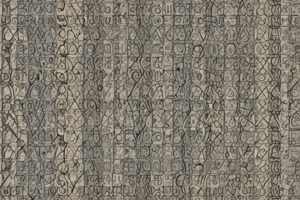Podcast
Questions and Answers
Explain the role of algebra in mathematics.
Explain the role of algebra in mathematics.
Algebra is used to solve equations using variables and to represent relationships among different quantities mathematically.
What are linear equations in algebra?
What are linear equations in algebra?
Linear equations involve one variable raised to the first power plus a constant value.
How does factoring polynomials simplify expressions?
How does factoring polynomials simplify expressions?
Factoring polynomials allows us to rewrite expressions in simpler forms.
Give an example of a problem that can be solved using algebraic equations.
Give an example of a problem that can be solved using algebraic equations.
Why are sequences and series important in mathematics?
Why are sequences and series important in mathematics?
What is the common difference in the arithmetic sequence {3, 8, 13, 18...}?
What is the common difference in the arithmetic sequence {3, 8, 13, 18...}?
In a geometric sequence {4, 12, 36, 108...}, what is the common ratio?
In a geometric sequence {4, 12, 36, 108...}, what is the common ratio?
What is the next term in the recursive sequence defined by the rule
$S_n = S_{n-1} + 2$, with $S_0 = 1$?
What is the next term in the recursive sequence defined by the rule
$S_n = S_{n-1} + 2$, with $S_0 = 1$?
For an arithmetic series with first term 3 and common difference 4, what is the sum of the first 10 terms?
For an arithmetic series with first term 3 and common difference 4, what is the sum of the first 10 terms?
If the sum of an infinite geometric series is 12, and the first term is 4, what is the common ratio?
If the sum of an infinite geometric series is 12, and the first term is 4, what is the common ratio?
Study Notes
Exploring Mathematical Concepts: Algebra, Sequences, and Series
Mathematics is a vast field with intricate connections between various disciplines, providing us with tools to make sense of our world through numbers and patterns. In this exploration, we'll dive into three fundamental subfields – algebra, sequences, and series. These concepts form the backbone of many other mathematical fields, including calculus, statistics, and computer science.
Algebra
Algebra is concerned with solving equations using variables instead of specific numerical values. It enables us to express relationships among different quantities by representing them mathematically. Let's consider two crucial aspects of algebra:
-
Linear Equations: These involve one variable raised to the first power plus a constant value. Solving linear equations can help reveal patterns and solve problems involving proportions and ratios. For instance, if you know that (x) grams of flour cost $2, how much does it cost to buy (y) grams? To find out, you would set up and solve the equation (x = \frac{2}{k} y,) where (k) represents the conversion ratio from grams to dollars.
-
Polynomials: A polynomial function has multiple terms containing some positive power of its single variable. Factoring polynomials allows us to rewrite expressions in simpler forms, which makes finding solutions easier. If you want to factor the expression (9x^2 - 8xy + 4y^2,) you might notice that it equals ((3x-2y)(3x+2y)).
Sequences
A sequence is an ordered list of elements, often following a pattern. We represent sequences using parentheses (( () )) or commas (,), denoting their position in the sequence. Some essential types of sequences are arithmetic, geometric, and recursive sequences.
-
Arithmetic Sequence: Each term differs from the previous one by a fixed amount called the common difference (( d )). For example, consider the sequence {2, 7, 12, 17...}. Here, ( d = 5.)
-
Geometric Sequence: Each term is obtained by multiplying the preceding term by a nonzero constant called the common ratio (( r )). An example of a geometric sequence is {2, 6, 18, 54...}, with ( r = 3.)
-
Recursively Defined Sequences: Certain sequences do not have explicit general rules but depend on prior terms. For instance, the Lucas sequence follows the rule [ L_n = L_{n-1} + L_{n-2},] starting with (L_0=0) and (L_1=1).
Series
Think of series as summing up sequences. When working with infinite series, convergence becomes critical to determining whether their sum will approach a finite value. There are several types of convergent and divergent series.
-
Arithmetic Series: These follow the sequence pattern discussed earlier and converge when the number of terms approaches infinity. By adding consecutive evenly spaced terms, we obtain an average that lies midway between the first and last terms.
-
Geometric Series: Summing infinitely many geometrically increasing terms results in a convergent series only when the absolute value of the common ratio ((|r|<1)). Otherwise, the series diverges to either negative or positive infinity.
As mathematics continues to evolve, these core ideas underpin advanced theories like analysis, topology, and abstract algebra. Understanding and applying algebraic concepts like functions, graphs, and transformations; employing sequences and series techniques to investigate patterns and create models; and being able to visualize and manipulate data will all serve as strong foundations for future learning within the beautiful subject of mathematics.
Studying That Suits You
Use AI to generate personalized quizzes and flashcards to suit your learning preferences.
Description
Explore fundamental mathematical concepts of algebra, sequences, and series, which are essential building blocks for various mathematical fields like calculus, statistics, and computer science. Dive into solving equations, analyzing sequences, and understanding the convergence of series to develop a strong mathematical foundation.




